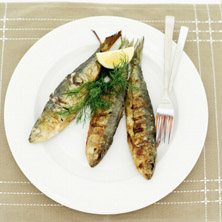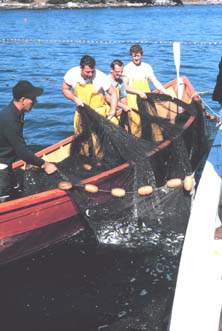Atlantic Herring (Clupea harengus)
- Atlantic herring populations are recovering and overfishing is no longer occurring.
- The Atlantic States Marine Fisheries Commission and the New England Fishery Management Council cooperate in the management of Atlantic herring in state and federal waters.
- Atlantic herring are a great source of omega-3s, vitamin B12, and iron. For more on nutrition, see Nutrition Facts. (USDA)
- Landings of Atlantic herring were 162.7 million pounds in 2007. Herring are marketed both as food and bait for the blue crab, lobster, and tuna fisheries.
|
 |
 |
 |
 |
| Nutrition Facts |
| Servings 1 |
| Serving Weight
100g |
 |
| Amount Per Serving |
 |
| Calories 158 |
 |
| Total Fat |
9.04 g |
 |
| Total Saturated Fatty Acids |
2.04 g |
 |
| Carbohydrate |
0 g |
| Sugars |
0 g |
| Total Dietary
Fiber |
0 g |
 |
| Cholesterol |
60 mg |
 |
| Selenium |
36.5 mcg |
 |
| Sodium |
90 mg |
 |
| Protein |
17.96 g |
 |
|
 |
 Herring migrate in schools to areas where they feed, spawn, and spend the winter. Herring migrate in schools to areas where they feed, spawn, and spend the winter.
|
 |
Did you know?
Atlantic herring are a highly valued commercial fishery for both domestic and foreign fishing fleets.
In the U.S., herring is marketed as canned sardines, steaks and kippers, and bait for the blue crab, lobster, and tuna fisheries. Some U.S.-caught herring is also sold to foreign ships that process it as frozen or salted fish.
When they spawn, herring deposit their eggs on the ocean bottom. Schools of herring can produce so many eggs that the ocean bottom is covered in a dense carpet of eggs several centimeters thick.
|
|
| |
 |
|
Herring are small and silvery, with a bluish or greenish blue back.
|
 |
|
Harvesting herring with a purse seine off the coast of Maine.
|
|
Sustainability Status
Biomass: Atlantic herring biomass is 65% above the biomass needed to support maximum sustainable yield.
Overfishing: No
Overfished: No
Fishing and habitat: U.S. fishermen almost exclusively use purse seines and mid-water trawls to catch herring. These types of gear do not typically contact the bottom and therefore have little effect on habitat.
Bycatch: The Atlantic herring fishery has little or no interactions with sea turtles but interactions with marine mammals have been recorded.
Aquaculture: There is currently no commercial aquaculture of Atlantic herring in the United States.
|
Science and Management
The Atlantic States Marine Fisheries Commission coordinates management of the herring fishery in state waters, and the New England Fishery Management Council manages the fishery in federal waters. The two entities develop their regulations in close coordination with each other. Current management measures include spawning area closures, an area management scheme (three areas), catch controls on the entire complex, and a Total Allowable Catch (TAC) on the near shore Gulf of Maine fishery. There is also a limited access permit program, allowing only those herring vessels that qualify for one of three limited access permits to continue to fish for herring. Vessels that do not qualify for any of the limited access permits can be issued an incidental catch permit.
|
Life History and Habitat
Life history, including information on the habitat, growth, feeding, and reproduction of a species, is important because it affects how a fishery is managed.
- Geographic range: Atlantic herring can be found in both the eastern and western halves of the North Atlantic Ocean. In the western Atlantic, herring range from Labrador, Nova Scotia to Cape Hatteras, North Carolina.
- Habitat: Atlantic herring inhabit coastal and continental shelf waters.
- Life span: Up to 15 years.
- Food: Atlantic herring feed on plankton, tiny floating plants and animals.
- Growth rate: Male and female herring grow at about the same rate.
- Maximum size: 14 inches.
- Reaches reproductive maturity: Atlantic herring are typically not fully mature until age 4. Their age at maturity varies annually, and changes appear to be dependent on density.
- Reproduction: Female herring can produce 30,000 to 200,000 eggs each. The eggs are typically deposited on a variety of bottom substrates including rocks, gravel, shell fragments, sand, and aquatic plants. Schools of herring can produce so many eggs that the ocean bottom is covered in a dense carpet of eggs several centimeters thick. Incubation is temperature dependent but usually occurs within 7 to 10 days. By late spring, larvae metamorphose into juvenile herring that may form large schools in coastal waters during the summer.
- Spawning season: Herring spawn as early as August in Nova Scotia and eastern Maine and during October and November in the southern Gulf of Maine, Georges Bank, and Nantucket Shoals.
- Spawning grounds: Atlantic herring mainly spawn in the Gulf of Maine and Georges Bank/Nantucket shoals over rock, gravel, or sand bottoms in areas of strong tidal currents and high salinity. Depths range from 50 to 150 feet deep.
- Migrations: Schools of adult herring make extensive migrations to areas where they feed, spawn, and spend the winter.
- Predators: Many species of fish, marine mammals, and seabirds prey on Atlantic herring.
- Commercial or recreational interest: Commercial
- Distinguishing characteristics: Atlantic herring is a small schooling fish. They are silvery in color, with a bluish or greenish-blue back.
|
Role in the Ecosystem
Atlantic herring is an important species in the food web of the northwest Atlantic Ocean throughout most, if not all, of its life. A variety of bottom-dwelling fish, including winter flounder, cod, haddock, and red hake, feed on herring eggs when they are deposited on the bottom. Juvenile herring are heavily preyed upon due to their abundance and small size. Atlantic herring are also important prey for a large number of fish, sharks, skates, marine mammals, and seabirds.
|
Additional Information
Market names: Herring, Sea Herring, Sild
Vernacular names: Common Herring, Labrador Herring, Sardine, Sperling
|
Biomass
Biomass refers to the amount of Atlantic herring in the ocean. Scientists cannot collect and weigh every single fish to determine biomass, so they use models to estimate it instead. These biomass estimates can help determine if a stock is being fished too heavily or if it may be able to tolerate more fishing pressure. Managers can then make appropriate changes in the regulations of the fishery.
Overfishing and the lack of management led to the complete collapse of Georges Bank herring stocks by 1977. The Georges Bank herring population began to recover in the mid-1980s, increasing an average of 0.7 pounds between 1983 and 2001. The juvenile herring fishery in the Gulf of Maine is not nearly as productive as it once was.
Note: Biomass of herring age 2 and older is shown in the graph.
Landings
 Landings refer to the amount of catch that is brought to land. The Georges Bank herring fishery was begun in 1961 by distant-water fleets. Landings peaked in 1968 at 373,600 metric tons and subsequently declined to 43,500 metric tons in 1976 as the fishery collapsed. Mid-water trawling by both U.S. and Canada herring fleets began in 1994, with landings peaking at 35,000 metric tons in 2001 and averaging about 13,000 metric tons from 1994 to 2005. The majority of Georges Bank herring landings are by U.S. mid-water vessels, with Canada taking the remainder. Landings refer to the amount of catch that is brought to land. The Georges Bank herring fishery was begun in 1961 by distant-water fleets. Landings peaked in 1968 at 373,600 metric tons and subsequently declined to 43,500 metric tons in 1976 as the fishery collapsed. Mid-water trawling by both U.S. and Canada herring fleets began in 1994, with landings peaking at 35,000 metric tons in 2001 and averaging about 13,000 metric tons from 1994 to 2005. The majority of Georges Bank herring landings are by U.S. mid-water vessels, with Canada taking the remainder.
After the large offshore fishery collapsed in 1977, the fishery focused on near shore waters of the Gulf of Maine. Landings gradually increased from the mid-1980s through the 1990s and peaked at 133,000 metric tons in 2001. Landings declined slightly from 2002 to 2005, averaging 109,000 metric tons.
Note: Total commercial landings are shown in the graph, which includes a minor amount from Canada.
Biomass and Landings
 Are landings and biomass related? Landings are dependent on biomass, management measures in the fishery, and fishing effort. Herring populations are naturally highly variable, perhaps due to changing environmental conditions. Fishing pressure exacerbated the variability and contributed to a crash in the herring stock and fishery in the 1970s.
Are landings and biomass related? Landings are dependent on biomass, management measures in the fishery, and fishing effort. Herring populations are naturally highly variable, perhaps due to changing environmental conditions. Fishing pressure exacerbated the variability and contributed to a crash in the herring stock and fishery in the 1970s.
Data sources:
Biomass from the 2006 Stock Assessment Report
Landings from NEFSC Status of Fishery Resources off the Northeastern U.S. - Atlantic herring
|
Important Dates
1972-1976 – Herring is managed by the International Commission for the Northwest Atlantic Fisheries (ICNAF)
1976-1978 – NMFS regulates foreign fishing through a preliminary FMP
1977 – Offshore herring fishery collapses
1978 – U.S. adopts its own FMP for Atlantic herring to manage herring stocks on Georges Bank and in the Gulf of Maine to achieve higher levels of spawning biomass and stable recruitment, and to rebuild the juvenile herring resource and sardine fishery in the Gulf of Maine
1982 – NMFS rescinds the 1978 FMP because of conflicts between state and federal regulations
1982 – Herring is placed on prohibited species list, eliminating directed fisheries for herring by foreign fleets within the U.S. EEZ and requiring any herring bycatch be discarded
1983 – ASMFC adopts Interstate FMP for Atlantic Herring
Mid-1980s – Georges Bank herring population begins to rebuild
1994 – ASMFC adopts new FMP to address the growth of the herring resource and interest in Internal Water Processing (IWP) operations
1999 – ASMFC adopts Amendment 1 to the Herring FMP to complement federal FMP
2003 – ASMFC and NEFMC develop new amendments to address to limited entry and other issues
2006 – Limited entry for herring vessels implemented through Amendment 1 to the Herring FMP
|
Notes and Links
General Information:
NEFMC Atlantic Herring page
ASMFC Atlantic Herring page
NEFSC Species Information: Atlantic Herring
NEFSC Essential Fish Habitat Source Document: Atlantic Herring Life History and Habitat Characteristics
Fishery Management:
NEFMC Atlantic Herring FMP
Summary of the NEFMC Atlantic Herring FMP
Stock Assessments:
NEFSC Status of Fishery Resources off the Northeastern U.S. - Atlantic herring
2006 Stock Assessment Report
|
| |
|



